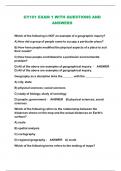Gy 101 lab Study guides, Class notes & Summaries
Looking for the best study guides, study notes and summaries about Gy 101 lab? On this page you'll find 36 study documents about Gy 101 lab.
Page 2 out of 36 results
Sort by
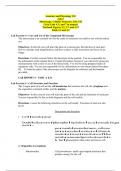
-
Anatomy and Physiology 101 Lab 2 Microscope, Cellular Structure, The Cell Cycle Labs 4, 5, and 7 in manual Textbook Figures 3.3, 3.7, and 3.37 Table 3.3 and 3.5
- Exam (elaborations) • 13 pages • 2024
-
- $13.49
- + learn more
Anatomy and Physiology 101 Lab 2 Microscope, Cellular Structure, The Cell Cycle Labs 4, 5, and 7 in manual Textbook Figures 3.3, 3.7, and 3.37 Table 3.3 and 3.5 Lab Exercise 4 - Care and Use of the Compound Microscope The microscope is an essential tool for the study of structures too small to see with the naked eye. Objectives- In this lab you will learn the parts of a microscope, the function of each part, how to calculate total magnification, and how to place a slide in position and...
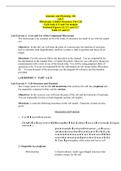
-
Anatomy and Physiology 101 Lab 2 Microscope, Cellular Structure, The Cell Cycle Labs 4, 5, and 7 in manual Textbook Figures 3.3, 3.7, and 3.37 Table 3.3 and 3.5
- Exam (elaborations) • 13 pages • 2023
-
- $14.98
- + learn more
Anatomy and Physiology 101 Lab 2 Microscope, Cellular Structure, The Cell Cycle Labs 4, 5, and 7 in manual Textbook Figures 3.3, 3.7, and 3.37 Table 3.3 and 3.5 Lab Exercise 4 - Care and Use of the Compound Microscope The microscope is an essential tool for the study of structures too small to see with the naked eye. Objectives- In this lab you will learn the parts of a microscope, the function of each part, how to calculate total magnification, and how to place a slide in position and...
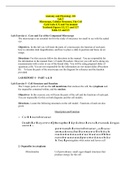
-
Anatomy and Physiology 101 Lab 2 Microscope, Cellular Structure, The Cell Cycle Labs 4, 5, and 7 in manual Textbook Figures 3.3, 3.7, and 3.37 Table 3.3 and 3.5
- Exam (elaborations) • 13 pages • 2023
-
- $15.49
- + learn more
Anatomy and Physiology 101 Lab 2 Microscope, Cellular Structure, The Cell Cycle Labs 4, 5, and 7 in manual Textbook Figures 3.3, 3.7, and 3.37 Table 3.3 and 3.5 Lab Exercise 4 - Care and Use of the Compound Microscope The microscope is an essential tool for the study of structures too small to see with the naked eye. Objectives- In this lab you will learn the parts of a microscope, the function of each part, how to calculate total magnification, and how to place a slide in position and...
GY 101 /GY101 PACKAGED EXAMS LATEST UPDATE 2024/2025...
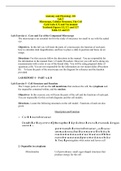
-
Anatomy and Physiology 101 Lab 2 Microscope, Cellular Structure, The Cell Cycle Labs 4, 5, and 7 in manual Textbook Figures 3.3, 3.7, and 3.37 Table 3.3 and 3.5
- Exam (elaborations) • 13 pages • 2022
-
- $15.49
- + learn more
Anatomy and Physiology 101 Lab 2 Microscope, Cellular Structure, The Cell Cycle Labs 4, 5, and 7 in manual Textbook Figures 3.3, 3.7, and 3.37 Table 3.3 and 3.5 Lab Exercise 4 - Care and Use of the Compound Microscope The microscope is an essential tool for the study of structures too small to see with the naked eye. Objectives- In this lab you will learn the parts of a microscope, the function of each part, how to calculate total magnification, and how to place a slide in position and...
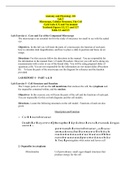
-
Anatomy and Physiology 101 Lab 2 Microscope, Cellular Structure, The Cell Cycle Labs 4, 5, and 7 in manual Textbook Figures 3.3, 3.7, and 3.37 Table 3.3 and 3.5
- Exam (elaborations) • 13 pages • 2022
-
- $15.49
- + learn more
Anatomy and Physiology 101 Lab 2 Microscope, Cellular Structure, The Cell Cycle Labs 4, 5, and 7 in manual Textbook Figures 3.3, 3.7, and 3.37 Table 3.3 and 3.5 Lab Exercise 4 - Care and Use of the Compound Microscope The microscope is an essential tool for the study of structures too small to see with the naked eye. Objectives- In this lab you will learn the parts of a microscope, the function of each part, how to calculate total magnification, and how to place a slide in position and...
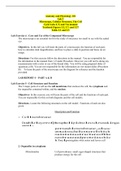
-
Anatomy and Physiology 101 Lab 2 Microscope, Cellular Structure, The Cell Cycle Labs 4, 5, and 7 in manual Textbook Figures 3.3, 3.7, and 3.37 Table 3.3 and 3.5
- Exam (elaborations) • 13 pages • 2022
-
- $13.49
- + learn more
Anatomy and Physiology 101 Lab 2 Microscope, Cellular Structure, The Cell Cycle Labs 4, 5, and 7 in manual Textbook Figures 3.3, 3.7, and 3.37 Table 3.3 and 3.5 Lab Exercise 4 - Care and Use of the Compound Microscope The microscope is an essential tool for the study of structures too small to see with the naked eye. Objectives- In this lab you will learn the parts of a microscope, the function of each part, how to calculate total magnification, and how to place a slide in position and...
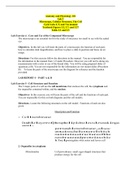
-
Anatomy and Physiology 101 Lab 2 Microscope, Cellular Structure, The Cell Cycle Labs 4, 5, and 7 in manual Textbook Figures 3.3, 3.7, and 3.37 Table 3.3 and 3.5
- Exam (elaborations) • 13 pages • 2022
-
Available in package deal
-
- $15.00
- + learn more
Anatomy and Physiology 101 Lab 2 Microscope, Cellular Structure, The Cell Cycle Labs 4, 5, and 7 in manual Textbook Figures 3.3, 3.7, and 3.37 Table 3.3 and 3.5 Lab Exercise 4 - Care and Use of the Compound Microscope The microscope is an essential tool for the study of structures too small to see with the naked eye. Objectives- In this lab you will learn the parts of a microscope, the function of each part, how to calculate total magnification, and how to place a slide in position and...
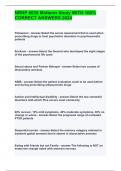
-
NRNP 6635 Midterm Study WITH 100% CORRECT ANSWERS 2024
- Exam (elaborations) • 16 pages • 2024
-
Available in package deal
-
- $7.99
- + learn more
1. coup-contre- coup injury 2. Scalp lacera- tion: what, effect, management 3. Skull fracture: types, effect, management 4. Brain injury: types, effect, management Dual impacting of the brain into the skull; coup injury occurs at the point of impact; contrecoup injury occurs on the opposite side of impact, as the brain rebounds. Primary head injury profuse bleeding - signs of hypovolemia Apply direct pressure Suture/ staple laceration Lidocaine 1% w...
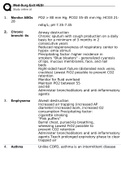
-
Med surg HESI EXIT EXAM|Updated (Updated Fall 2023) Test Bank.
- Exam (elaborations) • 67 pages • 2023
-
- $13.49
- + learn more
1. Monitor ABGs PO2 > 80 mm Hg; PCO2 35-45 mm Hg; HCO3 21-28 mEq/L; pH 7.35-7.45 2. Chronic bronchi- tis Airway destruction Chronic sputum with cough production on a daily basis for a minimum of 3 months in 2 consecutive years Reduced responsiveness of respiratory center to hypox- emia stimuli Precipitating factor: higher incidence in smokers "Blue bloaters" - generalized cyanosis of lips, mucous membranes, face, and nail beds Right-sided heart failure (distended neck veins, crackles...

That summary you just bought made someone very happy. Also get paid weekly? Sell your study resources on Stuvia! Discover all about earning on Stuvia

